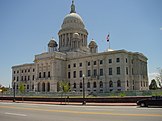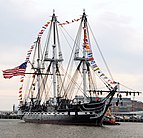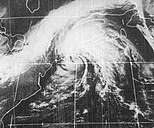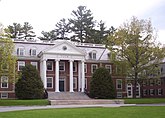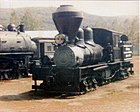Portal:New England/Selected article
Usage
The template for used to configure these sub-pages is located at {{Selected article}}
- Add a new Selected article to the next available sub-page.
- Update "max=" to new total for its {{Random portal component}} on the main page.
Selected article 1
Portal:New England/Selected article/1
USS Connecticut was the lead ship of the six Connecticut-class battleships. Due to the Royal Navy's commissioning of HMS Dreadnought seven months earlier, Connecticut was obsolete before she was commissioned; thus, she was the last lead ship of any class of pre-dreadnought battleship commissioned by the United States Navy. Connecticut served as a flagship for the Jamestown Exposition, which commemorated the 300th anniversary of the founding of the Jamestown colony. She later sailed with the Great White Fleet on a circumnavigation of the Earth to showcase the United States Navy's growing fleet of blue-water-capable ships. After the Great White Fleet returned to the U.S. on 22 February 1909, Connecticut participated in several flag-waving exercises intended to protect American citizens abroad until she was pressed into service as a troop transport at the end of World War I to expedite the return of American Expeditionary Forces from France. For the remainder of her career, Connecticut sailed to various places in both the Atlantic and Pacific while training newer recruits to the Navy. However, the provisions of the 1922 Washington Naval Treaty stipulated that many of the older battleships, Connecticut among them, would have to be disposed of, so she was decommissioned on 1 March 1922 and sold for scrap on 1 November 1923. (Full article...)Selected article 2
Portal:New England/Selected article/2
The 1689 Boston revolt was a popular uprising on April 18, 1689, against the rule of Sir Edmund Andros, the governor of the Dominion of New England. A well-organized "mob" of provincial militia and citizens formed in the city and arrested dominion officials. Members of the Church of England, believed by Puritans to sympathize with the administration of the dominion, were also taken into custody by the rebels. Neither faction sustained casualties during the revolt. Leaders of the former Massachusetts Bay Colony then reclaimed control of the government. In other colonies, members of governments displaced by the dominion were returned to power.Andros, commissioned governor of New England in 1686, had earned the enmity of the local populace by enforcing the restrictive Navigation Acts, denying the validity of existing land titles, restricting town meetings, and appointing unpopular regular officers to lead colonial militia, among other actions. Furthermore, he had infuriated Puritans in Boston by promoting the Church of England, which was disliked by many Nonconformist New England colonists. (Full article...)
Selected article 3
Portal:New England/Selected article/3
Plymouth Colony was an English colonial venture in North America from 1620 to 1691. The first settlement was at New Plymouth, a location previously surveyed and named by Captain John Smith. The settlement, which served as the capital of the colony, is today the modern town of Plymouth, Massachusetts. At its height, Plymouth Colony occupied most of the southeastern portion of the modern state of Massachusetts. Founded by a group including separatists who later came to be known as the Pilgrims, Plymouth Colony was, along with Jamestown, Virginia, one of the earliest colonies to be founded by the English in North America and the first sizable permanent English settlement in the New England region. Aided by Squanto, a Native American, the colony was able to establish a treaty with Chief Massasoit which helped to ensure the colony's success. The colony played a central role in King Philip's War, one of the earliest and bloodiest of the Indian Wars. Ultimately, the colony was annexed by the Massachusetts Bay Colony in 1691. Many of the people and events surrounding Plymouth Colony have become part of American mythology, including the North American tradition known as Thanksgiving and the monument known as Plymouth Rock. (Full article...)Selected article 4
Portal:New England/Selected article/4
Dartmouth College is a private, coeducational university located in Hanover, New Hampshire. It is a member of the Ivy League and one of the nine Colonial Colleges founded before the American Revolution. In addition to its undergraduate liberal arts program, Dartmouth has medical, engineering, and business schools, as well as 19 graduate programs in the arts and sciences. With a total enrollment of 5,849, Dartmouth is the smallest school in the Ivy League. Established in 1769 by Congregational minister Eleazar Wheelock with funds largely raised by the efforts of Native American preacher Samson Occom, the College's initial mission was to acculturate and Christianize the Native Americans in the area. After a long period of financial and political struggles, Dartmouth emerged from relative obscurity in the early twentieth century. In 2004, Booz Allen Hamilton selected Dartmouth College as one of the "World's Ten Most Enduring Institutions", recognizing its ability to overcome crises that threatened its survival (most notably in Trustees of Dartmouth College v. Woodward). Dartmouth alumni, from Daniel Webster to the many donors in the nineteenth and twentieth centuries, are famously involved in their college. (Full article...)Selected article 5
Portal:New England/Selected article/5
Providence is the capital of, and the most populous city in, Rhode Island, and one of the first cities established in the United States. Located in Providence County, it is the estimated third-largest city in the New England region. Despite the city proper only having an estimated population of 178,042 as of 2010, it anchors the 37th largest metropolitan population in the country. With an estimated MSA population of 1,600,856, it exceeds that of Rhode Island itself by about 60% due to its reaching into southern Massachusetts. Situated at the mouth of the Providence River, at the head of Narragansett Bay, the city's small footprint is crisscrossed by seemingly erratic streets and contains a rapidly changing demographic. Providence was founded in 1636 by Roger Williams, a religious exile from the Massachusetts Bay Colony. He named the area in honor of "God's merciful Providence", which he believed was responsible for revealing such a haven for him and his followers to settle. One of the first American cities to industrialize, Providence became noted for its jewelry and silverware industry. Today, the city's economy has shifted into the service industries, though it still retains significant manufacturing activity. (Full article...)Selected article 6
Portal:New England/Selected article/6
The Capture of Fort Ticonderoga occurred during the American Revolutionary War on May 10, 1775, when a small force of Green Mountain Boys led by Ethan Allen and Colonel Benedict Arnold overcame and looted a small British garrison. Cannons and other armaments from the fort were transported to Boston and used to fortify Dorchester Heights and break the stalemate at the Siege of Boston. After seizing Ticonderoga, a small detachment captured the nearby Fort Crown Point on May 11. On May 18, Arnold and 50 men boldly raided Fort Saint-Jean on the Richelieu River in southern Quebec, seizing military supplies, cannons, and the largest military vessel on Lake Champlain. Although the scope of this military action was relatively minor, it had significant strategic importance. It impeded communication between northern and southern units of the British Army, and gave the nascent Continental Army a staging ground for the invasion of Quebec later in 1775. It also involved two larger-than-life personalities in Allen and Arnold, each of whom sought to gain as much credit and honor as possible for these events. (Full article...)Selected article 7
Portal:New England/Selected article/7
The 1991 Perfect Storm, also known as the Halloween Nor'easter of 1991, was a nor'easter that absorbed Hurricane Grace and ultimately evolved into a small hurricane late in its life cycle. The initial area of low pressure developed off Atlantic Canada on October 28. Forced southward by a ridge to its north, it reached its peak intensity as a large and powerful cyclone. The storm lashed the East Coast of the United States with high waves and coastal flooding, before turning to the southwest and weakening. Moving over warmer waters, the system transitioned into a subtropical cyclone before becoming a tropical storm. It executed a loop off the Mid-Atlantic states and turned toward the northeast. On November 1 the system evolved into a full-fledged hurricane with peak winds of 75 miles per hour (120 km/h), although the National Hurricane Center left it unnamed to avoid confusion amid media interest in the predecessor extratropical storm. It later received the name "the Perfect Storm" after a conversation between Boston National Weather Service forecaster Robert Case and author Sebastian Junger. The system was the fourth hurricane and final tropical cyclone in the 1991 Atlantic hurricane season. The tropical system weakened, striking Nova Scotia as a tropical storm before dissipating. (Full article...)Selected article 8
Portal:New England/Selected article/8
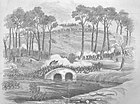
After garrison duty at the United States Naval Academy in Annapolis, Maryland, the regiment served with the Coast Division commanded by Maj. Gen. Ambrose Burnside. The Coast Division was deployed in January 1862 for operations on the coast of North Carolina, and participated in the Battle of Roanoke Island and the Battle of New Bern among other engagements. Burnside's division was recalled to Virginia in July 1862. The 21st Massachusetts was then attached to the Army of the Potomac and participated in several of the largest battles of the Civil War, including the Second Battle of Bull Run, the Battle of Antietam (capture of Burnside's Bridge pictured), and the Battle of Fredericksburg. The most devastating engagement of the war for the 21st was the Battle of Chantilly, fought on September 1, 1862, during which the unit suffered 35 percent casualties. From March 1863 to January 1864, the 21st served with Burnside in the Department of the Ohio, seeing action in Kentucky and eastern Tennessee. In May 1864, the regiment rejoined the Army of the Potomac, participating in Lt. Gen. Ulysses Grant's Overland Campaign and the Siege of Petersburg. (Full article...)
Selected article 9
Portal:New England/Selected article/9

Selected article 10
Portal:New England/Selected article/10
USS Constitution is a wooden-hulled, three-masted heavy frigate of the United States Navy. Named after the Constitution of the United States of America, she is the world's oldest commissioned naval vessel afloat. Launched in 1797, Constitution was one of six original frigates authorized for construction by the Naval Act of 1794 and the third constructed. Built in Boston, Massachusetts her first duties with the newly formed United States Navy were to provide protection for American merchant shipping during the Quasi-War with France and to defeat the Barbary pirates in the First Barbary War.Constitution is most famous for her actions during the War of 1812 against Great Britain, when she captured numerous merchant ships and defeated five British warships. The battle with HMS Guerriere earned her the nickname of "Old Ironsides" and public adoration that has repeatedly saved her from scrapping. She continued to actively serve the nation as flagship in the Mediterranean and African squadrons, and circled the world in the 1840s. During the American Civil War she served as a training ship for the United States Naval Academy and carried artwork and industrial displays to the Paris Exposition of 1878. Retired from active service in 1881, she served as a receiving ship until designated a museum ship in 1907. In 1931 she started a three-year, 90-port tour of the nation, and in 1997 she finally sailed again under her own power for her 200th birthday. (Full article...)
Selected article 11
Portal:New England/Selected article/11
The 22nd Regiment Massachusetts Volunteer Infantry was an infantry regiment in the Union army during the American Civil War. The 22nd Massachusetts was organized by Senator Henry Wilson (future Vice-President during the Ulysses Grant administration) and was therefore known as "Henry Wilson's Regiment." It was formed in Boston, Massachusetts, and established on September 28, 1861, for a term of three years.Arriving in Washington in October 1861, became part of the Army of the Potomac, with which it would be associated for its entire term of service. The regiment saw its first action during the Siege of Yorktown in April 1862. Their worst casualties in terms of percentages took place during the Battle of Gettysburg (memorial pictured). The 22nd was especially proficient in skirmish drill and was frequently deployed in that capacity throughout the war. (Full article...)
Selected article 12
Portal:New England/Selected article/12
Boston is the capital of Massachusetts and its largest city, and is one of the oldest cities in the United States. The largest city in New England, Boston is regarded as the unofficial "Capital of New England" for its economic and cultural impact on the entire New England region. The city proper, covering 48.43 square miles (125.43 square km), had a population of 617,594 according to the 2010 United States census. Boston is also the anchor of a substantially larger metropolitan area called Greater Boston, home to 4.5 million people and the tenth-largest metropolitan area in the country. Greater Boston as a commuting region is home to 7.6 million people, making it the fifth-largest combined statistical area in the United States.In 1630, Puritan colonists from England founded the city on the Shawmut Peninsula. During the late 18th century, Boston was the location of several major events during the American Revolution, including the Boston Massacre and the Boston Tea Party. Several early battles of the American Revolution, such as the Battle of Bunker Hill and the Siege of Boston, occurred within the city and surrounding areas. Through land reclamation and municipal annexation, Boston has expanded beyond the peninsula. After American independence was attained Boston became a major shipping port and manufacturing center, and its rich history helps attract many tourists, with Faneuil Hall alone attracting over 20 million every year. The city was the site of several firsts, including the United States' first public school, Boston Latin School, and the first subway system in the United States. (Full article...)
Selected article 13
Portal:New England/Selected article/13
Godsmack is an American heavy metal band from Lawrence, Massachusetts, formed in 1995. The band is composed of founder, frontman and songwriter Sully Erna, guitarist Tony Rombola, bassist Robbie Merrill, and drummer Shannon Larkin. Since its formation, Godsmack has released five studio albums, one EP, four DVDs, one compilation album collection and one live album.The band has had three consecutive number one albums (Faceless, IV, and The Oracle) on the Billboard 200. The band also has parked a ratified 20 top ten rock radio hits, including 15 songs in the Top Five, a record number of top ten singles by a rock artist. (Full article...)
Selected article 14
Portal:New England/Selected article/14
The humpback whale (Megaptera novaeangliae) is a species of baleen whale that can be found of the coast of New England. One of the larger rorqual species, adults range in length from 12–16 metres (39–52 ft) and weigh approximately 36,000 kilograms (79,000 lb). The humpback has a distinctive body shape, with unusually long pectoral fins and a knobbly head. It is an acrobatic animal, often breaching and slapping the water. Males produce a complex song, which lasts for 10 to 20 minutes and is repeated for hours at a time. The purpose of the song is not yet clear, although it appears to have a role in mating.Found in oceans and seas around the world, humpback whales typically migrate up to 25,000 kilometres (16,000 mi) each year. Humpbacks feed only in summer, in polar waters, and migrate to tropical or subtropical waters to breed and give birth in the winter. During the winter, humpbacks fast and live off their fat reserves. The species' diet consists mostly of krill and small fish. Humpbacks have a diverse repertoire of feeding methods, including the bubble net feeding technique. (Full article...)
Selected article 15
Portal:New England/Selected article/15
Lockdown (2008) was a professional wrestling pay-per-view (PPV) event produced by the Total Nonstop Action Wrestling (TNA) promotion, which took place on April 13, 2008 at the Tsongas Arena in Lowell, Massachusetts. It was the fourth under the Lockdown chronology and fourth event in the 2008 TNA PPV schedule. Eight professional wrestling matches, two of which for championships, were featured on the card. In the tradition of Lockdown events, every match took place inside a six sided steel structure known as the Six Sides of Steel. (Full article...)Selected article 16
Portal:New England/Selected article/16 The Museum of Bad Art (MOBA) is a privately owned museum in Massachusetts whose stated aim is "to celebrate the labor of artists whose work would be displayed and appreciated in no other forum". It has three branches, one in Dedham, another in nearby Somerville, and a third branch in Brookline. Its permanent collection includes 500 pieces of "art too bad to be ignored", 25 to 35 of which are on public display at any one time.
MOBA was founded in 1994, after antique dealer Scott Wilson showed a painting he had recovered from the trash to some friends, who suggested starting a collection. Within a year, receptions held in Wilson's friends' home were so well-attended that the collection required its own viewing space. The museum moved to the basement of a theater in Dedham. Explaining the reasoning behind the museum's establishment, co-founder Jerry Reilly said in 1995: "While every city in the world has at least one museum dedicated to the best of art, MOBA is the only museum dedicated to collecting and exhibiting the worst." To be included in MOBA's collection, works must be original and have serious intent, but they must also have significant flaws without being boring; curators are not interested in displaying deliberate kitsch. (Full article...)
Selected article 17
Portal:New England/Selected article/17
Right whales are three species of large baleen whales consisting of the genus Eubalaena in the family Balaenidae of order Cetacea. Their bodies are very dark gray or black and rotund.A popular explanation for the name "right whales" is that they were the "right" ones to hunt, as they float when killed and often swim within sight of shore. They are quite docile, and do not tend to shy away from approaching boats. As such, they were hunted nearly to extinction during the active years of the whaling industry. This origin is apocryphal. In his history of American whaling, Eric Jay Dolin writes: "Despite this highly plausible rationale, nobody actually knows how the right whale got its name. The earliest references to the right whale offer no indication why it was called that, and some who have studied the issue point out that the word 'right' in this context might just as likely be intended "to connote 'true' or 'proper,' meaning typical of the group. (Full article...)
Selected article 18
Portal:New England/Selected article/18
Summer of '42 is a 1971 American coming-of-age drama film based on the memoirs of screenwriter Herman Raucher. It tells the story of how Raucher, in his early teens on his 1942 summer vacation on Nantucket Island, off the coast of New England, embarked on a one-sided romance with a woman, Dorothy, whose husband had gone off to fight in World War II.The film was directed by Robert Mulligan, and starred Gary Grimes as Hermie, Jerry Houser as his best friend Oscy, Oliver Conant as their nerdy young friend Benjie, Jennifer O'Neill (pictured) as Hermie's mysterious love interest, and Katherine Allentuck and Christopher Norris as a pair of girls whom Hermie and Oscy attempt to seduce. Mulligan also has an uncredited role as the voice of the adult Hermie. (Full article...)
Selected article 19
Portal:New England/Selected article/19
Tropical Storm Carrie was a strong tropical storm that affected the East Coast of the United States in early September 1972. The third tropical cyclone of the 1972 Atlantic hurricane season, Carrie formed on August 29 from a complex sequence of meteorological events starting with the emergence of a tropical wave into the Atlantic in the middle of August. Tracking nominally northward throughout its life, Carrie reached an initial peak intensity as a moderate tropical storm before nearly weakening back into tropical depression status. The storm began to reintensify owing to baroclinic processes after turning toward the northwest; its winds of 70 miles per hour (110 km/h) eclipsed the cyclone's previous maximum strength as it was transitioning into an extratropical system. The extratropical remnants of Carrie skirted eastern New England before making landfall in Maine on September 4 and dissipating over the Gulf of Saint Lawrence over the next two days. (Full article...)Selected article 20
Portal:New England/Selected article/20
USS Massachusetts (Battleship No. 2) was an Indiana-class battleship and the second United States Navy ship comparable to foreign battleships of the time. Authorized in 1890 and commissioned six years later, she was a small battleship, though with heavy armor and ordnance. The ship class also pioneered the use of an intermediate battery. She was designed for coastal defense and as a result her decks were not safe from high waves on the open ocean.Massachusetts served in the Spanish–American War (1898) as part of the Flying Squadron and took part in the blockades of Cienfuegos and Santiago de Cuba. She missed the decisive Battle of Santiago de Cuba after steaming to Guantánamo Bay the night before to resupply coal. After the war she served with the North Atlantic Squadron, performing training maneuvers and gunnery practice. During this period she suffered an explosion in an 8-inch gun turret, killing nine, and ran aground twice, requiring several months of repair both times. She was decommissioned in 1906 for modernization. (Full article...)
Selected article 21
Portal:New England/Selected article/21
In September 1775, early in the American Revolutionary War, Colonel Benedict Arnold led a force of 1,100 Continental Army troops on an expedition from Cambridge, Massachusetts to the gates of Quebec City. Part of a two-pronged invasion of the British Province of Quebec, his expedition passed through the wilderness of what is now Maine.Unanticipated problems beset the expedition as soon as it left the last significant colonial outposts in Maine. The portages up the Kennebec River proved grueling, and the boats frequently leaked, ruining gunpowder and spoiling food supplies. Many of the troops lacked experience handling boats in white water, which led to the destruction of more boats and supplies in the descent to the Saint Lawrence River via the fast-flowing Chaudière.
By the time Arnold reached the French settlements above the Saint Lawrence River in November, his force was reduced to 600 starving men. Arnold's troops crossed the Saint Lawrence on November 13 and 14 and attempted to put Quebec City under siege. Failing in this, they withdrew to Point-aux-Trembles until Richard Montgomery arrived to lead an unsuccessful attack on the city. Arnold was rewarded for his effort in leading the expedition with a promotion to brigadier general. (Full article...)
Selected article 22
Portal:New England/Selected article/22
The Green is a grass-covered field and common space at the center of Dartmouth College, an Ivy League university located in Hanover, New Hampshire. It was among the first parcels of land obtained by the college upon its founding in 1769, and is the only creation of the 18th century remaining at the center of the campus. After being cleared of pine trees, it initially served as a pasture and later as an athletic field for college sporting events. Today, it is a central location for rallies, celebrations, and demonstrations, and serves as a general, all-purpose recreation area. The college describes the Green as "historic" and as the "emotional center" of the institution. (Full article...)Selected article 23
Portal:New England/Selected article/23
The Amos Tuck School of Business Administration (or the Tuck School of Business at Dartmouth, as it is now called) is the graduate business school of Dartmouth College in Hanover, New Hampshire. Founded in 1900, Tuck is the oldest graduate school of business in the world, and was the first institution to offer master's degrees in the field of business administration. Tuck is one of six Ivy League business schools and it consistently ranks in the top five in many business school rankings.Tuck grants only one degree, the Master of Business Administration (MBA), alongside shorter programs for executives and recent college graduates, although there are opportunities for dual degrees with other institutions. The school places a heavy emphasis on its tight-knit and residential character, and has a student population that hovers near 500 students and a full-time faculty of 46. Tuck claims over 8,400 living alumni in a variety of fields, with the highest rate of alumni donation of any business school. (Full article...)
Selected article 24
Portal:New England/Selected article/24
Steamtown, USA was a steam locomotive museum that ran steam excursions out of North Walpole, New Hampshire, and Bellows Falls, Vermont, from the 1960s to 1983. The museum, which was founded by millionaire seafood industrialist F. Nelson Blount, was operated primarily by the non-profit Steamtown Foundation following his death in 1967. Because of Vermont air quality regulations that restricted steam excursions, declining visitor attendance, and disputes over the use of track, some pieces of the collection were relocated to Scranton, Pennsylvania, in the mid 1980s, while the rest were auctioned off. After the move, Steamtown, USA continued to operate in Scranton but failed to attract the expected 200,000–400,000 visitors. Within two years the tourist attraction was facing bankruptcy, and more pieces of the collection were sold to pay off debt.By 1995, Steamtown had been acquired and developed by the National Park Service with a $66 million allocation. Since the government acquisition, several more pieces have been removed from the collection. A part of the Blount collection is still on display at the Steamtown National Historic Site in Scranton, while several other pieces have been sold or traded and are located in various locations throughout the United States and Canada. (Full article...)
Selected article 25
Portal:New England/Selected article/25
Adiantum viridimontanum, commonly known as Green Mountain maidenhair fern, is a rare fern found only in outcrops of serpentine rock in New England and Canada. The leaf blade is cut into finger-like segments, themselves once-divided, which are borne on the outer side of a curved, dark, glossy rachis (the central stalk of the leaf). These finger-like segments are not individual leaves, but parts of a single compound leaf. The "fingers" may be drooping or erect, depending on whether the individual fern grows in shade or sunlight. Spores are borne under false indusia (rolled flaps of tissue) at the edge of the subdivisions of the leaf, a characteristic unique to the genus Adiantum.Until 1991, A. viridimontanum was grouped with the western maidenhair fern, A. aleuticum, which grows both in western North America and as a disjunct on serpentine outcrops in eastern North America. At one time, A. aleuticum itself was classified as a variety (A. pedatum var. aleuticum) of the northern maidenhair fern, A. pedatum. However, after several years of study, botanist Cathy Paris recognized that A. aleuticum was a distinct species, and that some of the specimens that had been attributed to that taxon (group of organisms) were a third, hybrid species intermediate between A. pedatum and A. aleuticum. She named the new species A. viridimontanum for the site of its discovery in the Green Mountains in Vermont; it has since been located in Quebec and in one site on serpentine in coastal Maine. (Full article...)
Selected article 26
Portal:New England/Selected article/26
Hurricane Gloria was a powerful Cape Verde-type hurricane that formed during the 1985 Atlantic hurricane season and prowled the Atlantic Ocean from September 16 to September 28. Gloria reached Category 4 status on the Saffir-Simpson Hurricane Scale near the Bahamas, but weakened significantly by the time it made landfall on North Carolina's Outer Banks. Gloria closely followed the Mid-Atlantic coastline and made a second landfall on Long Island, and, after crossing the Long Island Sound, it made a third landfall in Connecticut.Overall, the storm caused extensive damage along the East Coast of the United States, amounting to $900 million ($2.55 billion in today's terms[1]), and was responsible for eight fatalities. The storm was the first significant system to strike the northeastern United States since Hurricane Agnes in 1972 and the first major storm to affect New York and Long Island directly since Hurricane Donna in 1960. (Full article...)
Selected article 27
Portal:New England/Selected article/27
The 2004 World Series was the Major League Baseball (MLB) championship series for the 2004 season. It was the 100th World Series and featured the American League (AL) champions, the Boston Red Sox, against the National League (NL) champions, the St. Louis Cardinals. The Red Sox defeated the Cardinals four games to none in the best-of-seven series, played at Fenway Park and Busch Memorial Stadium. The series was played between October 23 and October 27, 2004, broadcast on Fox, and watched by an average of just under 25 and a half million viewers.The Red Sox defeated the Anaheim Angels in the American League Division Series and the New York Yankees in the Championship Series (ALCS), to advance to their first World Series since 1986. The Red Sox won the World Series for the first time since 1918, which ended the "Curse of the Bambino," a curse that was supposed to have been inflicted on the team when Babe Ruth was sold to the Yankees in 1919. With the New England Patriots winning Super Bowl XXXVIII, the event made Boston the first city to have Super Bowl and MLB World Championships in the same year since Pittsburgh in 1979. (Full article...)
- ^ 1634–1699: McCusker, J. J. (1997). How Much Is That in Real Money? A Historical Price Index for Use as a Deflator of Money Values in the Economy of the United States: Addenda et Corrigenda (PDF). American Antiquarian Society. 1700–1799: McCusker, J. J. (1992). How Much Is That in Real Money? A Historical Price Index for Use as a Deflator of Money Values in the Economy of the United States (PDF). American Antiquarian Society. 1800–present: Federal Reserve Bank of Minneapolis. "Consumer Price Index (estimate) 1800–". Retrieved February 29, 2024.





